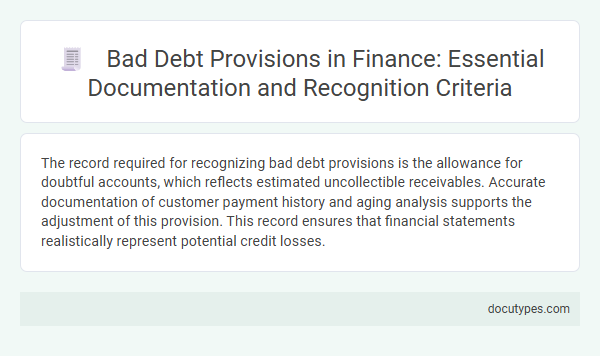The record required for recognizing bad debt provisions is the allowance for doubtful accounts, which reflects estimated uncollectible receivables. Accurate documentation of customer payment history and aging analysis supports the adjustment of this provision. This record ensures that financial statements realistically represent potential credit losses.
Introduction to Bad Debt Provisions in Finance
Bad debt provisions are essential financial records that estimate potential losses from uncollectible accounts receivable. Proper recognition of these provisions ensures accurate financial reporting and compliance with accounting standards.
- Allowance for Doubtful Accounts - This account is used to record the estimated uncollectible amounts from credit sales.
- Bad Debt Expense - Represents the cost associated with estimated uncollectible receivables during a specific period.
- Write-off Records - Document the removal of specific uncollectible receivables from the accounting books once deemed uncollectible.
Importance of Accurate Bad Debt Documentation
Accurate documentation is essential for recognizing bad debt provisions in finance. Proper records ensure compliance with accounting standards and support the validity of the provision.
The required record typically includes detailed accounts receivable aging reports and customer payment histories. These documents help identify doubtful accounts and estimate potential losses accurately.
Key Recognition Criteria for Bad Debt Provisions
Recognizing bad debt provisions involves specific accounting records that reflect the anticipated uncollectible amounts. Accurate documentation ensures compliance with financial reporting standards and facilitates effective credit risk management.
- Identification of Doubtful Accounts - Records must clearly identify receivables with significant default risk based on customer payment history and credit evaluations.
- Estimation of Bad Debt Amount - The provision should be calculated using historical loss rates, aging analysis, or expected credit loss models to quantify the expected uncollectible sum.
- Journal Entry for Provision - An adjusting entry debiting Bad Debt Expense and crediting Allowance for Doubtful Accounts must be recorded to reflect the provision accurately.
Regulatory Framework and Compliance Standards
What record is required for recognizing bad debt provisions under the regulatory framework and compliance standards? You must maintain detailed documentation of all identified doubtful accounts, including supporting evidence such as customer credit evaluations and historical payment data. Regulatory standards mandate that this record be systematically updated and readily accessible for audit and compliance verification.
Methods for Identifying Doubtful Accounts
Recognizing bad debt provisions requires maintaining accurate records of doubtful accounts to estimate potential credit losses. Companies use specific methods to identify these accounts and determine appropriate allowance amounts.
Common methods for identifying doubtful accounts include analyzing aging receivables, reviewing customer payment history, and assessing economic conditions affecting debtor solvency. The aging method categorizes accounts based on the length of time invoices remain unpaid to highlight overdue balances. Evaluating payment patterns and financial stability helps predict the likelihood of default, ensuring reliable bad debt provision.
Essential Elements of Supporting Documentation
Bad debt provisions require accurate and comprehensive records to ensure proper financial reporting. Essential elements of supporting documentation include detailed customer account histories, evidence of collection efforts, and communication records indicating financial difficulties. You must maintain these documents to validate the reasonableness of the bad debt provision and comply with accounting standards.
Best Practices for Bad Debt Estimation
Recognizing bad debt provisions requires accurate record-keeping of historical loss data and current account receivables. Best practices for bad debt estimation involve systematic evaluation of credit risks and timely adjustments based on financial performance.
- Historical Loss Records - Maintain detailed records of previous bad debts to identify loss patterns and inform realistic provision levels.
- Current Receivables Analysis - Regularly review outstanding accounts with aging schedules to assess the likelihood of default.
- Risk Assessment Models - Utilize quantitative models incorporating customer credit ratings and economic conditions to enhance estimation accuracy.
Consistent documentation and periodic revision of bad debt provisions support compliance and financial transparency.
Impact of Bad Debt Provisions on Financial Statements
| Record Required for Recognizing Bad Debt Provisions |
|---|
| A detailed Allowance for Doubtful Accounts or Bad Debt Provision record is essential. This record typically includes the estimated amount of receivables that may not be collected, based on historical data, current economic conditions, and specific customer analysis. The provision is recognized by debiting Bad Debt Expense and crediting Allowance for Doubtful Accounts. |
| Impact of Bad Debt Provisions on Financial Statements |
| Bad debt provisions impact your financial statements in several ways. On the income statement, recognizing bad debt expense reduces net income, reflecting anticipated losses from uncollected receivables. On the balance sheet, the allowance account reduces accounts receivable, presenting a more realistic value of collectible assets. Accurate bad debt provisioning enhances the reliability of financial statements and informs better decision-making. |
Internal Controls and Audit Requirements
Recognizing bad debt provisions requires maintaining detailed records of outstanding receivables, aging reports, and historical loss experience. Your internal controls must ensure accurate documentation and periodic review to validate the adequacy of the provision. Audit requirements mandate clear evidence of assessment methods, approval by management, and consistency with accounting standards for impairment recognition.
What Record Is Required for Recognizing Bad Debt Provisions? Infographic

